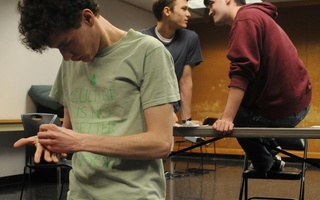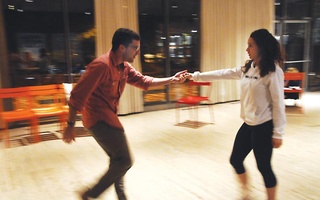A couple weeks from now millions of people will line up to watch the first of two movies based on the seventh Harry Potter book. Some will come hours in advance, some in costume, some with friends; some will cheer at the end of the movie, some may cry, and many will come back to watch again. All will come to see the story of a boy coming of age in a magical world; all will come compelled by the spell of a fairy story. But what kind of powerful spell is it that calls so many, regardless of age or class or taste?
My fourth grade teacher gave me “The Fellowship of the Ring,” but my love of fantasy began much earlier than that. C.S. Lewis’s Narnia books and Susan Cooper’s “The Dark is Rising” sequence were childhood favorites; something in me leapt up at the idea that a wardrobe could lead to an enchanted kingdom, that an uncle-turned-magician could open the way into a shadowy realm at the edges of my world. Harry’s crossing through the back of a London pub into magical Diagon Alley struck that same chord.
J.R.R. Tolkien’s address titled “On Fairy Stories” at the University of St. Andrews in 1939, a year after the publication of “The Hobbit,” helps to explain this phenomenon. In this lecture he set out not only to define the fairy story—which he considers a nearly impossible task—but also to defend it from charges of escapism.
I grant that my childhood reading was an escape. But what kind of escape was it? An escape to mere delusion, to worlds that lured me away from reality, away from this realm of limited possibilities where animals never speak and wardrobes lead only to the last forgotten coat and the hard finality of a dusty wooden panel?
Tolkien wouldn’t have thought so. On the contrary, Tolkien thinks much of his contemporaries’ literature—literature straining for realism—escaped reality by denying universal human experiences in favor of modern minutiae, by being more concerned with factory chimneys than with trees.
“Much that... others would call ‘serious’ literature,” Tolkien writes, “is no more than play under a glass roof by the side of a swimming pool bath. Fairy-stories may invent monsters that fly the air or dwell in the deep, but at least they do not try to escape from heaven or the sea.”
In fantasy, then, we escape from the narrow confines of our own limited experience, from the crippling conviction that there is such a thing as “just” a tree or indeed “just” anything at all. In fantasy we learn to reengage the real.
Tolkien suggests that this was the direction artists of his time should take, artists growing bored of the same old art, however skillfully wrought: rather than turn on the old art, turning to purposeful misshapenness in rebellion against the well-shaped but stale, they must make us see what is old as if it were wild and new—to meet the centaur and the dragon in order to greet the horse and snake with appropriate wonder.
In “The Hosting of the Sidhe,” as in several of his early poems, W.B. Yeats acts out the escape offered by the fairy story. “Empty your heart of its mortal dream,” cries Niamh, the daughter of the god of the sea in Irish mythology. Yeats continues, “The host is rushing ‘twixt night and day, / And where is there hope or deed as fair? / Caolite tossing his burning hair, / And Niamh calling Away, come away.”
Over the course of his career Yeats also turns away from folklore only to return at last to the reality that greets us at the turn of the fairy-tale’s final page. “The Circus Animals’ Desertion,” from his last collection, has a sense of bitterness, of his being unable and unwilling to enumerate old fantastical themes. The poet is led at last back to the ground of his inspiration, the hard dirt in which his visions took root: “Now that my ladder’s gone / I must lie down where all the ladders start / In the foul rag and bone shop of the heart.”
The old “masterful images” of his early poetry have faded, yet the beauty of these final lines undercuts the bitterness of that departure, sends off the old tales with fitting tenderness, and suggests the heartbreaking inexorability of the final return to reality. And this is what millions will line up to experience this November: the journey from the fantastical around at last to the terrible splendor of things as they are, a reality still more startling than the most wonder-filled tale of the wondrous realm of faerie.
—Columnist Adam T. Horn can be reached at adamhorn@college.harvard.edu.
Read more in Arts
Steven Page Scrawls Parody On His ‘Page One’Recommended Articles
-
 The Pillowman
The Pillowman -
 Into the Woods
Into the Woods -
Tatar Discusses Development of Fairy TalesProfessor Maria Tatar, the chair of the Committee on Degrees in Folklore and Mythology, noted the historical evolution of fairy tales in a lecture Thursday at the Dudley branch of the Boston Public Library in Roxbury.
-
‘Mirror Mirror’ Reflects Changing Gender NormsBetween the beautiful cinematography and underlying messages of social acceptance, "Mirror Mirror" is justifiably sweeter than the Grimm Brothers’ original.
-
By Its CoverToo lazy to read a book? Judge its cover instead. In this fortnightly feature, a revolving slew of writers will analyze new releases based on their dust jackets alone. This week, contributing writer Ege Yumusak predicts a book season full of introspection, money-grubbing, and stalkers.
-
In the event that you survive the apocalypse on December 21, 2012, look out for...10 things to live for in the new year













